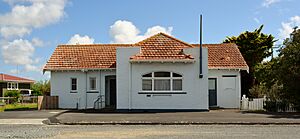Ruawai facts for kids
Quick facts for kids
Ruawai
|
|
|---|---|

Former Ruawai Post Office and telephone exchange
|
|
| Country | New Zealand |
| Region | Northland Region |
| District | Kaipara District |
| Ward | Otamatea Ward |
| Electorates |
|
| Area | |
| • Total | 3.21 km2 (1.24 sq mi) |
| Population
(June 2023)
|
|
| • Total | 520 |
| • Density | 162.0/km2 (420/sq mi) |
Ruawai (which means 'two waters' in Māori) is a small town in Northland, New Zealand. It's about 30 kilometers south of Dargaville. The name comes from the nearby Northern Wairoa River and Kaipara Harbour.
Ruawai is a farming town. It's especially known for growing kumara, a type of sweet potato. People in Ruawai even call their town the "Kumara capital of the world"!
The local Naumai Marae and Ngā Uri o te Kotahitanga meeting house is a special gathering place for the Ngāti Whātua and Te Uri o Hau Māori tribes.
Contents
History of Ruawai
In the late 1800s and early 1900s, Ruawai was a place where people dug for kauri gum. Kauri gum was a valuable natural resin from kauri trees, used for things like varnish.
People of Ruawai
Statistics New Zealand describes Ruawai as a rural settlement. It covers about 3.21 square kilometers. In the 2023 New Zealand census, Ruawai had 480 people living there. This was a small increase from the 2018 census.
- There were 246 males and 234 females.
- The average age was 48.6 years.
- About 19.4% of the people were under 15 years old.
- Most people (78.1%) identified as European (Pākehā).
- A large number (41.2%) identified as Māori.
- English was spoken by almost everyone (98.1%).
- About 5.0% of people also spoke the Māori language.
- Most people either had no religion (49.4%) or were Christian (36.2%).
Ruawai-Matakohe Area
Ruawai is part of a larger area called Ruawai-Matakohe. This area also includes the towns of Matakohe and Tinopai. This bigger area covers about 530 square kilometers. In the 2023 census, the Ruawai-Matakohe area had 2,631 people.
Education in Ruawai
Ruawai has two main schools:
- Ruawai College: This is a secondary school for students in years 7 to 13.
- Ruawai School: This is a primary school for younger students in years 1 to 6.
Both schools teach boys and girls together. In 1995, Ruawai College was one of the first schools in New Zealand to get a fast internet connection for the whole campus. This helped the school and the local community get online easily.
Notable People from Ruawai
Some well-known people have connections to Ruawai:
- Lockwood Smith: A politician from New Zealand.
- Roy Billing: A famous New Zealand actor who grew up in Ruawai and went to Ruawai High School.
- Grace Gooder

